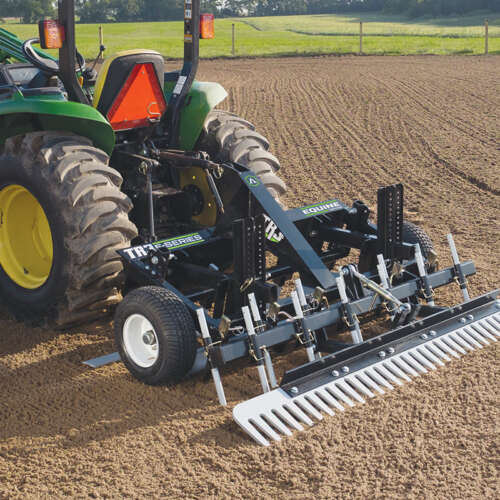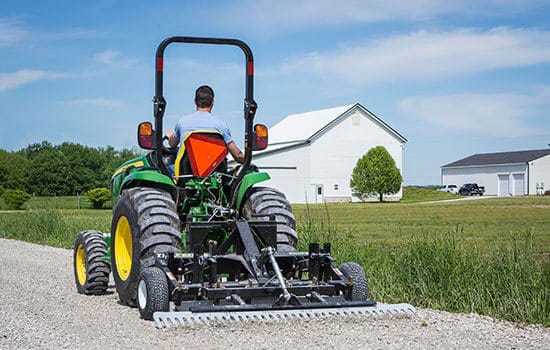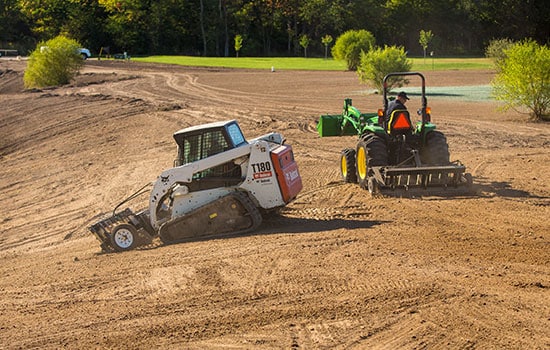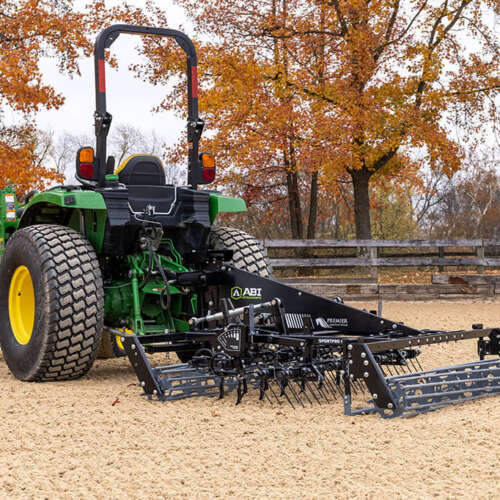Ground Engaging Components Guessing Game
What’s in the Box?
ABI’s Director of Engineering, Nate Smith, takes over hosting the Dirt to test Matt’s knowledge on ground engaging components.
For more information on these or other attachments visit us at abiattachments.com or call a Product Specialist at 877.788.7253
ABI Products Shown In This Video

TR3 “E” Equine Edition
- For Sub-Compact & Compact Tractors, #1 Selling Arena Drag
- 6', 7', 8' Widths
- Starting At: $128/mo.*
Transcript
– Hello, I’m Nate Smith and welcome to the ABI Dirt. Today we’re gonna be talking about ground engaging components.
– Hang on. Whoa, whoa, whoa, whoa whoa. What Nate, what are you doing man?
– [Nate] I’m hosting today.
– [Matt] You’re, what am I supposed to do?
– [Nate] Yeah, I’m hosting today. You’re gonna put on this blindfold.
– [Matt] Oh no.
– [Nate] So, this is a test of what you understand about our ground engaging components on our attachments.
– [Matt] Oh, that’s, this is gonna be good.
The Games Begin! Nate Puts Matt’s Knowledge to the Test
– [Nate] Okay, Matt, so I want you to reach in and just touch the ground engaging component one time and tell me what it is.
– [Matt] Rock.
– [Nate Laughs] Finger prints on the glasses. I deserve that. Okay, Matt, I want you to reach-
– [Matt] Okay, I got one touch.
– [Nate] Yes, I want you to reach into the box and touch it one time.
– [Matt] With my palm, with my, like?
– [Nate] Yeah.
Test #1 – The Coil Tine
– [Matt] Okay.
– [Nate] And what do you think it is?
– [Matt] Okay, so that seems to be one of the like thinnest diameter ground engage components we have, I felt two of them with a big ol’ palm slap and that’s gotta be something in the realm of like a spring tine something.
– [Nate] Hey! Yes.
– [Matt] I dunno how much I shouldn’t mess with them.
– [Nate] Yes. So we call this a coil tine. It’s designed to have relief and to fracture and mix.
– [Matt] Right on.
Benefits of the Coil Tine
– [Nate] Used primarily in synthetic horse arenas and materials that have fibers in them where they need the relief.
– [Matt] Now, for people who have been around the dirt for a while and have seen a lot of the ground engaged components we have, this is a bit thinner of a ground engaged component than we use on many of our attachments. Why is that? Why do you prefer something like this particularly in, like, synthetic footing arenas?
– [Nate] Because it needs to have the added relief to spring back and it can’t have buildup. That material, especially with the fibers, can build up and wrap around and plug. So, you avoid that with an engagement like that.
– [Matt] Right on.
Test #2 – The Finish Rake
– [Nate] Okay Matt, I want you to try this next one. Just reach into the box and just touch it.
– [Matt] Oh, I don’t know about that one. Definitely got like a palm full of like a flat blade of some kind. Is that, we’re looking like a profile blade?
– [Nate] Oh no, I need you to reach in. You get a little bit more of a touch.
– [Matt] No? Alright, I’ll pull it out. Oh! Okay. See I only got the flat part of it. Okay. So yeah, no, this is- Oh, oh this is a good one. You got a good one here buddy. All right, so we’re looking at- This is a section of a finish rake, 12 inch section because of the two bolts here, it’s not a rounded wing on the edge piece. I think it is probably too light to be the 3/4 inch. So I’m guessing it is a 1/2 inch thickness. Probably powder coat gray, am I right?
Benefits of the Anti 70 Gray Finish Rake
– [Nate] Anti 70 gray to be specific! And thank you very much. Take off the blindfold. Goof! Yes. This is our finish rake. All of our tools in natural horse arenas finish with this because it feathers out, leaves a beautiful finish and does the right balance of putting- leaving some air in the material but pressing some out of it. And it’s adjustable, especially like on our TR3 E-series that lets you adjust that to feather it out. You mentioned the bend in the end, that’s intentional and it is so we get that nice feathered finish. On many of our tools.
– [Matt] On the far left side, far right side on the E-series. Right? So a 1/2 inch thick finish rake like this, correct me if I’m wrong here, Nate. This is the TR3 E-series as well as the rascal line. And this also can be found on the underbody weldment of the ABI force, right?
– [Nate] Correct. Correct. On the, the TR3, the original tool that’s out of a much heavier material for like our contractor tools or our SR3s, that’s an abrasion resistant 3/4 inch rake.
– [Matt] Got it. Right on. You had me on that one.
Test #3 – The S-Tine
– [Nate] Okay Matt. Reach your hand in the box for the next one.
– [Matt] This is always so scary.
– [Nate Laughs] We’re gonna put a snake in there for one of these.
– [Matt] I gotta pick that one up. I’ve got no idea. Oh! Gotcha. Okay, so I got it on the side. So yeah, we’ve got a coil here, right? Gives it away with a curved blade here at the end with a one bolt. So this would be, we’re talking the S-tine, or the spring tine, on- this is the new sport pro lineup, right?
Benefits of the S-Tine (For Synthetic Arenas)
– [Nate] Yep. Hey! So we use S-tines that give relief again, in material that has a lot of fiber content and so it gives relief. Now why don’t we want to use this in a natural footing arena, is because this gives relief, which is great, except for it doesn’t actually go to a uniform depth. And so it will struggle to break up really hard compaction that clay creates in a natural arena.
– [Matt] Yeah. And so we prefer these in the, in the synthetic arenas. Any kind of arena has like a rubber mat or any kind of hydration up underneath the arena. This is fantastic because then it, it gives, right? So, you’re not gonna grab that rubber mat underneath. Whereas, in traditional dirt arenas where you’ve got either stone base, like crushed stone or a thick heavy pressed clay base, well they can handle something a little bit more aggressive and you can get that uniform depth then.
– [Nate] Yep.
– [Matt] And, correct me if I’m wrong, Nate, aren’t these reversible here? So, you can actually get wear on both sides of that.
– [Nate] Yep. You can just flip this thing right over. The other interesting thing is, on our sport pro series, we can change the angle of engagement.
– [Matt] On the whole assembly right?
– [Nate] The whole assembly actually turns, pivots on this, again to change how aggressive and how much, how this point actually contacts the material.
– [Matt] Right on.
Test #4 – Two Types of Scarifiers
– [Nate] Okay Matt. Now I gotcha. Try this one.
– [Matt] Oh no. Are you saving the best for last?
– [Nate] Yeah.
– [Matt] All right. I think I’ve got an idea, but can I pick it up to make sure, because I felt, I think there’s like a bolthead in there, right? Isn’t there?
– [Nate] No, no, no, no, no, no. You gotta just give me a guess.
– [Matt] If I- uh. I think it’s a scarifier complete. That’s what I think it is.
– [Nate] Okay.
– [Matt] Did I get it?
– [Nate] Yep.
– [Matt] Ah yeah! Landed right with the bolt head.
– [Nate] But you only got half of it!
– [Matt] Alright, well chill out.
– [Nate] So no, no, no, no, no. You can take off the blindfold there.
– [Matt] Hey! Yep. Scarifier complete.
– [Nate] But look in the box.
– [Matt] Oh! You sneak. You didn’t tell me there were two things in the box.
– [Nate] I didn’t have to tell you there were two things in the box.
– [Matt] Two kinds of scarifiers. All right, Nate, talk me through what are the differences?
Benefits of Using Different Types of Scarifiers
– [Nate] Yeah, Why the heck do we need two different kinds of scarifiers? So, one of the first contrasts that we’re gonna make here is the thickness. So again, in our high fiber sport pro line we need a thinner scarifier, so we don’t have extra buildup. If we try to run a scarifier like this through that material, it’s all gonna wrap up. It’s gonna ride up, it’s gonna bunch up, it’s gonna plug. It’s not gonna be a good experience. But, if I’m working in a gravel driveway or fracturing heavy clay or prepping a seed bed I want the big scarifier. I don’t want this smaller, thinner one. These are also made out of an abrasion resistant steel to make ’em last longer. But, the replaceable tips are the way to go if you’re working in those other varied materials.
– [Matt] Well, and these are, I know you’re comparing kind of ground engaging for arena scenarios, but these are the same kind of shanks and tips used on gravel work. Right? So, for the gravel rascal line for the TR3 E-series, property edition line, for the the SRTR line when you’re digging through heavily compacted like, like hard pan. This is the same, same setup.
– [Nate] Yep. Yep. It’s those tips.
– [Matt] Right on.
– [Nate] Way to go.
Test #5 – Nate’s Turn – The Cultipacker Wheel
– [Matt] Hey, you trick me on the two-for. But, now since you did me dirty putting two in the box, it’s your turn.
– [Nate] Oh man.
– [Matt] All right Nate, same deal man. Reach in the box, one touch, see what you think.
– [Nate] Oh. Can I do it one more time?
– [Matt] No! You didn’t let me do it another time. I’m just kidding. Go ahead. Yeah.
– [Nate] Oh man. Feels like a roll of duct tape.
– [Matt Laughs] Ooh, that would’ve been so much better.
– [Nate] Okay, I gotta pick it up.
– [Matt] All right, pick it up. See if you can figure it out.
– [Nate] Oh, it’s a cultipacker wheel.
– [Matt] Yeah, there you go. Yeah.
Benefits of a Cultipacker Wheel
– [Matt] Okay. For those of you watching at home we just pulled this off the R&D shelf. Don’t actually know if this is in production or not, but we figured Nate could figure it out.
– [Nate] Yeah, so, so this, this is a prototype like plastic one that we were playing with, but it makes the point. So, cultipackers are used for firming up seed bed for promoting soil to seed contact and just generally setting and it’ll set a nice pattern in your seed bed. Also break up clay clots. So we offer different variations, tow-behind or even underbelly on the force.
– [Matt] Right on. Nice work. You got it, man.
– [Nate] And usually they are cast iron and that’s what kind of goofed me up.
– [Matt Laughs] Are you saying that I would trick you, Nate?
Thanks for Watching the ABI Dirt!
– [Nate] Yes. Yes, you would. That’s all we have for the ABI Dirt. Thanks for watching. Thanks for joining me, Matt.
– [Matt] I know when I’m not wanted.
– [Nate] And we’ll see you next time.




